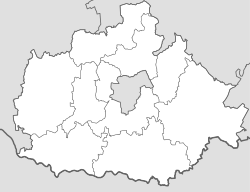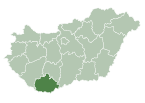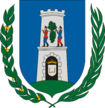Bakonya
Bakonya | |
|---|---|
Village | |
 Local history museum in Bakonya | |
| Coordinates:46°05′08″N18°05′02″E/ 46.08569°N 18.08382°E | |
| Country | |
| County | Baranya |
| District | Pécs |
| Area | |
| • Total | 15.07 km2(5.82 sq mi) |
| Population (1 Jan 2019)[1] | |
| • Total | 336 |
| • Density | 22/km2(58/sq mi) |
| Time zone | UTC+1(CET) |
| • Summer (DST) | UTC+2(CEST) |
| Postal code | 7675 |
| Area code | 72 |
| NUTS 3 code | HU231 |
| HCSO code | 08299 |
| Website | bakonya |
Bakonyais a village (Hungarian:község) in centralBaranya County,Pécs District,in southernHungary.It is located in the westernMecsek mountain rangeand was the site of auranium minefrom the 1950s to 1989. Its population at the2011 Censuswas 335.[2]
Etymology
[edit]The name comes from theSlavicbukovina:beech forest.[3][4]
Geography
[edit]The village is located at 46° 5′ 12″ N, 18° 4′ 51″ E. Its area is 15.07 km2(5.82 sq mi). It is part of theSouthern Transdanubiastatistical region, and administratively it falls underPécs DistrictofBaranya County.
It lies 11.9 km (7.4 mi) west of the city ofPécs[5]and is bordered by the villages ofHetvehelyto the north,Kővágótöttösto the east,Bicsérdto the south, andBodato the west.
Bakonya is located in the westernMecsek Mountains,and the northern half of the village area lies within theWestern Mecsek Landscape Protection District,managed by theDanube-Dráva National Park.[6]

The area is rich in minerals compared to other parts of Hungary, anduranium orewas discovered insandstonedeposits near Bakonya, with production beginning in the mid-1950s. The uranium was of low grade, but production was subsidized by the government until 1989, when the mine closed following the collapse of theSoviet Union,the primary consumer of the ore, rendering the operation no longer economically viable.[citation needed]
Demographics
[edit]| Year | Pop. | ±% |
|---|---|---|
| 1870 | 618 | — |
| 1880 | 565 | −8.6% |
| 1890 | 585 | +3.5% |
| 1900 | 546 | −6.7% |
| 1910 | 571 | +4.6% |
| 1920 | 548 | −4.0% |
| 1930 | 552 | +0.7% |
| 1941 | 594 | +7.6% |
| 1949 | 598 | +0.7% |
| 1960 | 553 | −7.5% |
| 1970 | 500 | −9.6% |
| 1980 | 453 | −9.4% |
| 1990 | 363 | −19.9% |
| 2001 | 416 | +14.6% |
| 2011 | 335 | −19.5% |
| 2019 | 336[1] | +0.3% |
| Source:Hungarian Central Statistical Office[2] | ||
2011 census
[edit]As of thecensus of 2011,there were 335 residents, 136 households, and 93 families living in the village. Thepopulation densitywas 58 inhabitants per square mile (22/km2). There were 140 dwellings at an average density of 24 per square mile (9/km2).
There were 136households,of which 64.0% were one-family households, 2.2% were multi-family households, 30.1% were one-person households, and 3.7% were other non-family households. The average household size was 2.46.
There were 93families,of which 40.9% were couples living with children, 39.8% were couples living without children, 12.9% were single females with children, and 6.5% were single males with children. The average number of children was 1.13. The average family size was 2.94.
The age breakdown of the village was 21.2% under the age of 20, 7.8% between ages 20 and 24, 25.4% aged 25 to 44, 31.0% aged 45 to 64, and 14.6% aged 65 and older. Thegender ratiowas 1.06 males to every female.
In terms of educational attainment, 92.6% completed at leastprimary school,26.9% completed at leastsecondary schoolwith final examination, and 5.0% had ahigher education degree.[2]
Religious affiliation was 49.9%Roman Catholic,1.2%Calvinist,0.9%Lutheran,0.3%Greek Catholic,1.2% other religion, and 26%unaffiliated,with 20.6% declining to answer.
The village had anethnic minorityRomapopulation of 15.2%. The other minority nationality affiliation of note wasGerman(2.1%), with small numbers ofPoles,Croats,and others, non-native to Hungary, each constituting less than 1% of the population. The vast majority declared themselves asHungarian(94.9%), with 3.9% declining to answer.[note 1][7]
Local government
[edit]The village is governed by amayorwith a four-person council. The local government of the village operates ajoint council officewith the nearby localities ofCserkútandKővágószőlős.The seat of the joint council is in Kővágószőlős.[1][8]
As of the election of 2019, the village also has a localminority self-governmentfor itsRomacommunity, with three elected representatives.[9]
Mayors since 1990
[edit]| Mayor | Party | Term(s) of Office | |
|---|---|---|---|
| Janz Anikó | Independent | 2019- | |
| István Varga | Independent | 2014-2019 | |
| 2010-2014 | |||
| 2006-2010 | |||
| 2002-2006 | |||
| 1998-2002 | |||
| András Vakaró | Independent | 1994-1998 | |
| 1990-1994 | |||
Transportation
[edit]Railway
[edit]- Bicsérd Train Station,7 km (4.3 mi) to the south of the village offRoad 6601.The station is on thePusztaszabolcs–PécsandGyékényes–Pécsrailway lines and is operated byMÁV.
Road
[edit]- Road 6605,which passes through the Mecsek mountain range, connects toMain Road 6in the south andHetvehelyatRoad 6601in the north.
- Main Road 6,which runs south of the village, connects east-west toSzentlőrincandPécs.
Notes
[edit]- ^As a person can affiliate themselves with more than one ethnic group (nationality), the totals may be greater than 100%.
References
[edit]- ^abcd"Gazetteer of Hungary, 1 January 2019"(PDF).Hungarian Central Statistical Office.Retrieved22 June2020.
- ^abc"Population Census 2011: Regional Data - Baranya County".Hungarian Central Statistical Office.1 October 2011.Retrieved22 June2020.
- ^Kiss, Lajos (1978).Földrajzi nevek etimológiai szótára(in Hungarian). Budapest: Akadémiai. p. 76.
- ^Stanislav, Ján(2004).Slovenský juh v stredoveku II(in Slovak). Slovenské literárne centrum. p. 20.ISBN80-88878-89-6.
- ^"Distance Calculator Find Distance Between Cities".Distance Calculator.Retrieved2020-07-20.
- ^"Western Mecsek Landscape Protection District".Danube-Dráva National Park Directorate(in Hungarian).Retrieved2020-06-27.
- ^"Detailed Gazetteer of Hungary: Abaliget".Hungarian Central Statistics Office.Retrieved30 June2020.
- ^"Local government elections 2019 - Bakonya (Baranya County)".Hungarian National Election Office(in Hungarian).Retrieved20 July2020.
- ^"Nationality local government elections 2019 - Bakonya (Baranya County)".Hungarian National Election Office(in Hungarian).Retrieved20 July2020.
- ^"Download election results, 1990-2019".Hungarian National Election Office(in Hungarian). 29 October 2019.Retrieved1 July2020.
External links
[edit]- Bakonya village website(in Hungarian)
- Map of the Western Mecsek Landscape Protection District(in Hungarian)
- Street map(in Hungarian)
- OpenStreetMap






